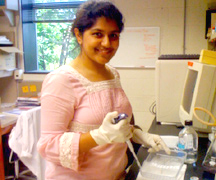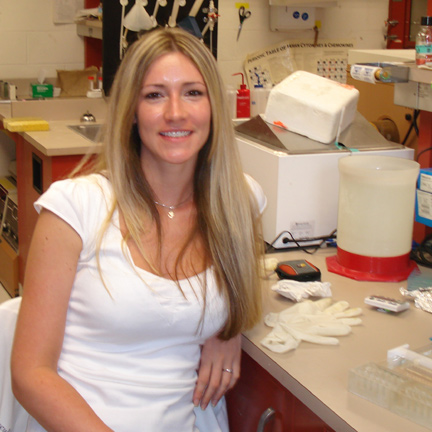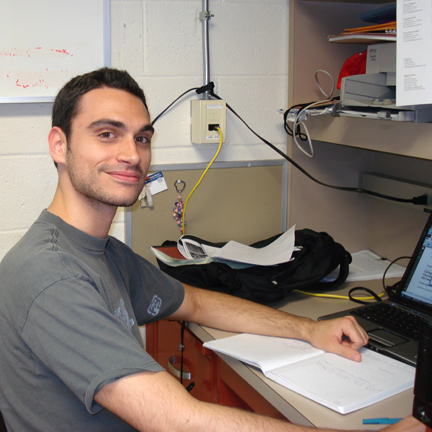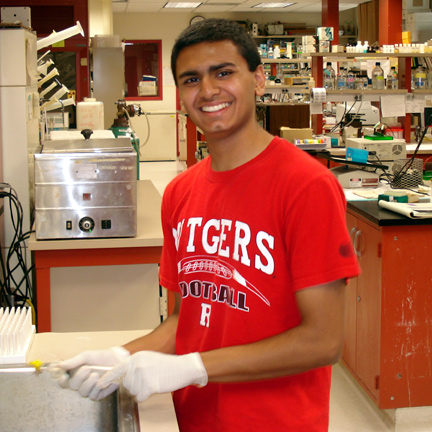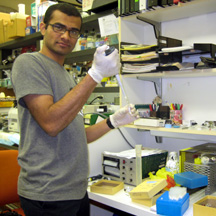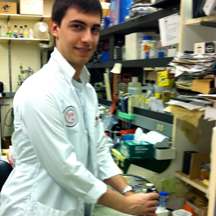|
2011 Update:
Since my last posting in 2009 our research has progressed on a number of fronts. Most notably perhaps was the completion of Sunanda Baliga’s PhD studies, which have resulted in a publication in PLoS One (PLoS One. 2011 Jan 21;6) entitled “Osteopontin Expression during Early Cerebral Ischemia-Reperfusion in Rats: Enhanced Expression in the Right Cortex is Suppressed by Acetaminophen” co-authored with Drs. Gary Merrill and Mari Shinohara. Sunanda was first featured in the 2008 update below. The abstract of this publication reads “Osteopontin (OPN) is a pleiotropic protein implicated in various inflammatory responses including ischemia-reperfusion (I-R) injury. Two distinct forms of the protein have been identified: an extensively studied secreted form (sOPN) and a less-well-known intracellular form (iOPN). Studies have shown that increased OPN expression parallels the time course of macrophage infiltration into injured tissue, a late event in the development of cerebral infarcts. sOPN has been suggested to promote remodeling of the extracellular matrix in the brain; the function of iOPN may be to facilitate certain signal transduction processes. Here, we studied OPN expression in adult male Sprague-Dawley rats subjected to global forebrain I-R injury. We found iOPN in the cytoplasm of both cortices and the hippocampus, but unexpectedly only the right cortex exhibited a marked increase in the iOPN level after 45 min of reperfusion. Acetaminophen, a drug recently shown to decrease apoptotic incidence, caspase-9 activation, and mitochondrial dysfunction during global I-R, significantly inhibited the increase in iOPN protein in the right cortex, suggesting a role for iOPN in the response to I-R injury in the right cortex.”
Kathryn (Kate) Jaques-Robinson also finished her PhD research (see the 2009 update) and is currently working on a manuscript tentatively entitled “Acetaminophen Attenuates Doxorubicin-induced cardiac fibrosis via OPN and GATA4 regulation”. These collaborative studies with Dr. Merrill, a Professor of Systems Physiology in the Rutgers Department of Cell Biology and Neuroscience on the involvement of acetaminophen and osteopontin in cardiac and cerebral injury are leading us in exciting new directions.
Luke Coyle, please see the 2009 update,
completed his MSc thesis in collaborative studies with Kate intended to shed
light on whether OPN is a regulator of LIF mRNA levels in the AtT-20 mouse
pituitary cell line [Ciccotosto GD, Schiller MR, Eipper BA, Mains RE. (1999)
Induction of integral membrane PAM expression in AtT-20 cells alters the storage
and trafficking of POMC and PC1. J Cell Biol.144:459-71.] This is an attempt to
get at the role of OPN in determining corticosterone levels in mice exposed to
stress as first described by Kathryn Wang in publications cited below. The
abstract of his thesis reads “The highly phosphorylated glycoprotein Osteopontin
(OPN) is a multifaceted protein with a diversity of roles in many immunological
processes, and has recently been found to have a significant role in the
Hypothalamus-Pituitary-Adrenal (HPA) axis. Its role was discovered when
unstressed OPN-knockout mice were found to have abnormally high basal
corticosterone levels, which is the hormone typically elevated following stress
induction of the HPA axis.
Most of the rest of our research during
the last few years has focused on completing the characterization
of the set of anti-OPN monoclonal antibodies produced by the novel
hybridomas we have created. These studies have been conducted by a
group of talented undergraduates working in my laboratory over the
past 8 years and are acknowledged in previous postings. They have
been joined recently by
Nady Hin, Kiran Patel,
and Theodore
Drashansky, who are pictured here.
Because I retired in July, 2010 and closed down my lab, it seems appropriate to end this entry with my CV/Resume (in case anyone wants to hire me) and a piece I wrote (“50 years of Basic Research”) for the Swarthmore Coot (The Class of 1960 reunion yearbook) on the occasion of my 50th anniversary of graduation from Swarthmore College.
Publications from my laboratory not previously listed: Baliga SS, Merrill GF, Shinohara ML, Denhardt DT. Osteopontin Expression during Early Cerebral Ischemia-Reperfusion in Rats: Enhanced Expression in the Right Cortex Is Suppressed by Acetaminophen. PLoS One. 2011 Jan 21;6(1):e14568 Wang KX, Shi YF, Ron Y, Kazanecki CC, Denhardt DT. Plasma osteopontin modulates chronic restraint stress-induced thymus atrophy by regulating stress hormones: inhibition by an anti-osteopontin monoclonal antibody. J Immunol. 2009 182:2485-91. Wang KX, Denhardt DT. Osteopontin: role in immune regulation and stress responses. Cytokine Growth Factor Rev. 2008 19:333-45. Other publications that my name pulls up on PubMed are the recent results of collaborations with other laboratories, notably Drs. Hwyda Arafat, Masaki Noda, Esben Sorensen, Larry Steinman, and Toshi Uede. |
